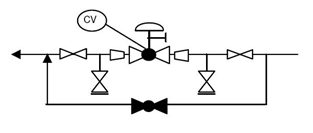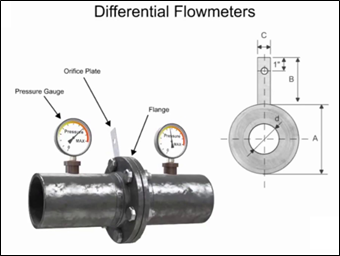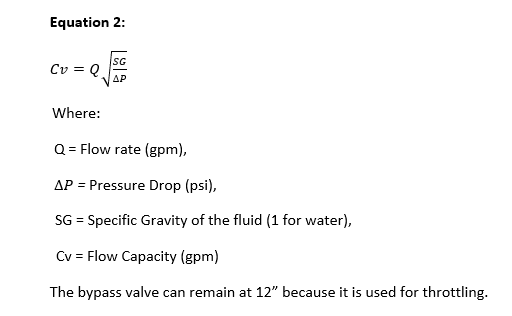Valve Selection for Bypass of Control Valves: A Case Study
A bypass line including a bypass valve is typically installed to provide continuous operation in case of regular maintenance of a control valve.
#maintenance-repair
Generally, the control valve marked as CV in Figure 1 is smaller than the line size, so it is located between a reducer and an expander. Two block valves (e.g., ball or butterfly or gate valves) are provided upstream and downstream of the control valve to shut down the line in case of valve maintenance.
Two small (¾” or 1”) gate valves are located upstream and downstream of the control valve for drainage of two piping segments. There is a bypass valve (depicted in black) that is normally closed but will be opened for control valve maintenance. It is important that the bypass valve has a flow capacity close to the control valve to supply almost the same amount of flow through the system.
The next part of this article will focus on challenges related to the selection, sizing and operation of this bypass valve.
CASE STUDY
A 12” Class 150 22Cr duplex flow control valve is in a cooling water system. The manual bypass of this valve was a 12” Class 150 wafer-type butterfly valve, chosen to save weight and cost compared to alternative options such as a globe valve.
Figure 2 illustrates the control valve arrangement including the bypass butterfly valve as well as two 14” isolation butterfly valves upstream and downstream of the control valve. All the valves in Figure 3 are in ASME pressure Class 150.
The Cv value of the control valve is 495 gallons per minute (gpm). The flow coefficient, or Cv, is a universal capacity index and is simply defined as “the number of U.S. gallons of water per minute at 60°F that will flow through a valve with a pressure drop of one psi.” The 12” bypass butterfly valve provides a Cv value of 4563 gpm, which is much higher than the control valve.
FIVE POSSIBLE SOLUTIONS
1. Changing the type of the bypass valve
Globe valves have higher pressure drop and less Cv value compared to butterfly valves in the same size and pressure class. Additionally, globe valves have better flow control characteristics and range ability. The disadvantage of this solution is increased cost, and this solution is not preferred if the bypass valve has already been ordered as a butterfly valve. Figure 3 illustrates a globe valve during the inspection.
2. Ordering a butterfly valve with specific Cv
Generally, it could be a good solution for ordering the bypass valve with a special Cv close to the control valve. However, it is not possible to have a 12” butterfly valve with a Cv value as small as 495 gpm. Ordering a valve with special Cv increases the cost since the valve is different from the standard valve manufacturer product.
3. Reducing the size of the butterfly valve on the bypass line
The Cv value of the 4” butterfly valve in this case is 234 gpm, which is too low. On the other hand, a 6” butterfly valve has a Cv value of 819 gpm, which is higher than the required Cv. Therefore, both sizes cannot satisfy the required Cv in fully open condition. However, it is possible to partially open the 6” butterfly valve to get a flow capacity close to the control valve.
4. Using an orifice plate (disk) to reduce the flow capacity
An orifice plate is a device used for measuring flow rate, reducing pressure or restricting flow (in the latter two cases it is often called a restriction plate). The orifice plate should be installed after the bypass valve to limit the flow capacity. Orifice plate is installed between orifice flanges and the pressure values upstream and downstream of the orifice are measured through pressure gauges in Figure 4.
5. Considering the bypass valve for throttling (flow control)
The manual bypass valve is not 100% percent open during the operation. Thus, the operator should partially open the butterfly valve to get a flow capacity close to the control valve.
Valve suppliers provide a flow characteristic curve based on the opening percentage of the valve. As an example, Figure 5 indicates the flow capacity of the butterfly valves in different sizes from 3” to 36” based on the opening degree of the valve. The values of flow capacity have been given in Kv values. The relationship between Cv and Kv values is given through equation 1. Kv indicates the flow capacity of a valve in m3/h, which flows through the valve at a pressure drop of 1Bar.
The opening angle of the bypass valve can be adjusted to provide a Cv value close to the control valve. A flow transmitter should be installed on the pipe to measure the flow rate passing through the bypass valve during the valve operation. It is possible to calculate the flow capacity by knowing the Cv value of the valve through equation number 2.
CONCLUSION AND RECOMMENDATIONS
For operation, sizing and selection of a manual valve on a bypass line, the flow capacity or Cv value of the bypass valve should be almost the same as the control valve.
A 12” wafer-type butterfly valve was selected for the bypass line, which has higher flow capacity than the control valve. Different solutions to solve this issue were offered, but the preferred solution is to reduce the size of the valve to 6” according to solution number 3 and use the valve for throttling on the condition that the 12” valve has not been ordered. Using a flow orifice (restriction orifice) can be a good solution if a 12” butterfly valve has already been ordered and is subject to a high cancellation cost. Alternatively, the 12” valve could be opened partially to get specific flow capacity close to the control valve as per solution number 5.
Karan Sotoodeh is specialist piping and valve engineer at Aker Solutions.
RELATED CONTENT
-
Actuator Issues? Use This Checklist!
While there may be 40 reasons valve actuators may stop working, there really is only a handful of components that can cause the problems. So, if you have an actuator on the fritz, here are the five things you need to check.
-
Cobalt-based Alloy 6 Materials and Boiler Feedwater Service
Q: I’ve heard that cobalt-base Alloy 6 materials should not be used in boiler feedwater service.
-
HVOF Coatings for Severe Service Valves
Chrome carbide is one coating that can be done during manufacturing or repairs that extends service life of valves and other flow control components.

















 Unloading large gate valve.jpg;maxWidth=214)